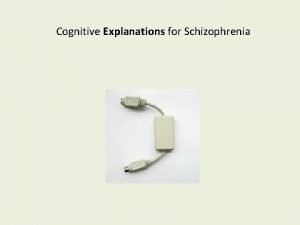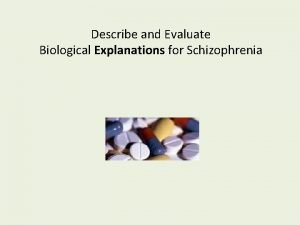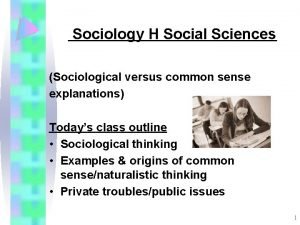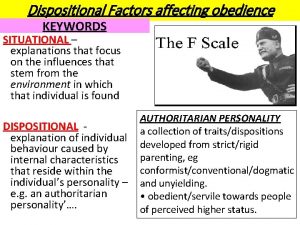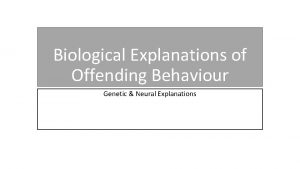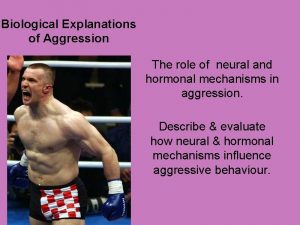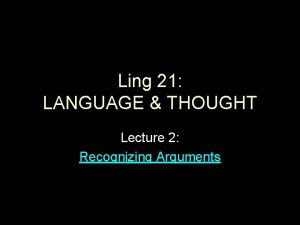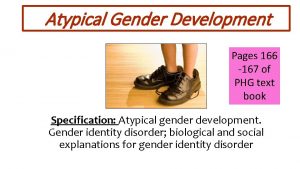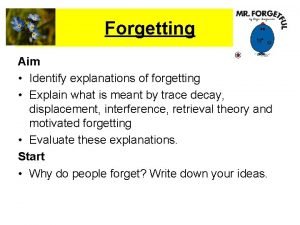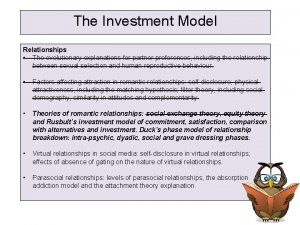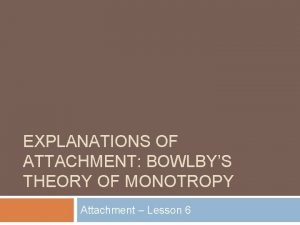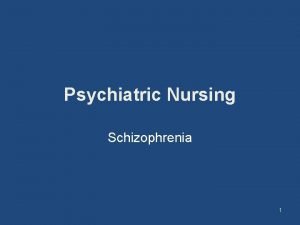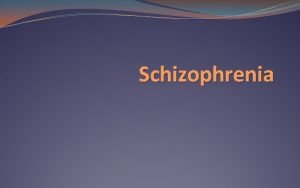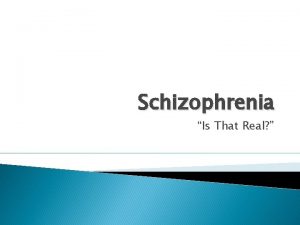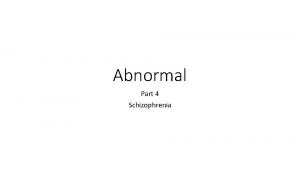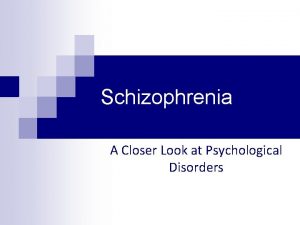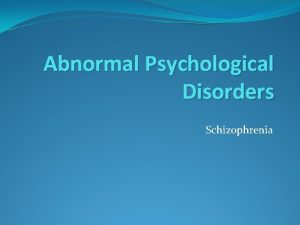Psychological Explanations of Schizophrenia Psychological explanations are so














- Slides: 14

Psychological Explanations of Schizophrenia

Psychological explanations are so named because they arise from major psychological perspectives, or thought socio-cultural factors, in that they stress the role of social and family relationships in the development of schizophrenia.

Psychological Theories Psychodynamic – Fronted by Freud (1924), proposed schizophrenia is the result of: • Regression to a pre-ego stage. • Attempts to re-establish ego control. Ego = driven by the reality principle which works to satisfy the ID in realistic ways. Makes the person accommodate to the demands of the environment.

Regression to Pre-Ego + Attempts to Re-establish Ego Control An individual may regress to this early stage in their development before the ego was properly formed if schizophrenics world is harsh, e. g. cold and uncaring parents, before the child had developed realistic awareness of the external world. Schizophrenia is seen as an infantile state, positive symptoms of delusions of grandeur reflect this condition. Whereas auditory hallucinations reflect a persons attempt to re-establish ego control – control of reality.

Cognitive Theory This explanation of schizophrenia acknowledges the role of biological factors in causing the initial sensory experiences of schizophrenia, but claims that further features of the disorder appear as individuals attempt to understand those experiences. When an individual experiences first sensory symptoms, they turn to friends and relatives to help understand validate them. They fail to do this, so the schizophrenic begins to believe they are hiding things from them (paranoia) – this then causes the individual to reject the feedback and develop delusional beliefs that they are being manipulated.

Evaluation of Psychological Theories Psychotherapeutic Explanations – There is little evidence to support Freud’s ideas, except subsequent psychoanalysts claiming that the disorder is caused by disordered family patterns. Fromm-Reichmann (1948) stated that ‘schizophrenogenic mothers’ or families, who are rejecting, overprotective, dominant and moralistic as important contributory influences. This again is supported by further evidence that parents of schizophrenic patients do behave differently from other parents, Oltsmann (1999) but it is hard to discern the cause and effect – different parental behaviour may be the result of their child’s disorder.

Cognitive Explanations – There is physical evidence for the cognitive deficits associated with schizophrenia, Meyer. Lindenberg (2002), which found a link between excess dopamine in the prefrontal cortex, and working memory. The suggestion that ‘madness’ is a consequence of disbelieving others receives support for a recent treatment, Yellowlees (2002) developed a virtual hallucinations machine, which seems like the TV is telling you to kill yourself, or a person’s face morphing into another – the intention being to show schizophrenics that their hallucinations are not real. There is no evidence as of yet to show that this will provide an effective treatment.

Socio-Cultural Factors

Life Events Stressful life events may be linked with a higher risk of schizophrenic episodes. These events are discreet stresses, such as the death of a close relative or the break-up of a relationship. Brown and Birley (1968) found that prior to a schizophrenic episode, patients who had previously experienced schizophrenia reported twice as many stressful life events in the three weeks prior to the episode, compared to a healthy control group, of whom only 12% experienced such an event nine weeks prior. Changes in the levels of neurotransmitters are thought to be involved in the way stress factors trigger schizophrenia.

Family Relationships • These can be divided into two factors, interpersonal communication and expressed emotion. • Interpersonal Communication – Some theorist have argued that thee are abnormal and inadequate patterns of communication with the families of schizophrenic patients. Bateson (1956) put forward a double-bind theory, according to which the members of families of schizophrenics communicate in a destructively ambiguous fashion, i. e. a mother may tell her child that she loves him, but in a tone of voice that doesn’t indicate love. • Expressed Emotion – What seems to be important is the extent to which a family engages in expressed emotion, which involves criticism, hostility, and emotional overinvolvement. Individuals who have suffered from schizophrenia and who live in families with high expressed emotion are nearly four times as likely to relapse compared with those who live in families with low expressed emotion (Kavanagh, 1992).

Labelling Theory • This theory was popularised by Scheff (1999), who stated that social groups construct rules for their group to follow. The symptoms of schizophrenia (hallucinations, delusions and bizarre behaviour) are seen as deviant from the rules we ascribed as normal behaviour. If a person displays these unusual forms of behaviour, they are considered deviant, and the label of ‘schizophrenic’ may be applied. Once this diagnostic label is applied it becomes a self-fulfilling prophecy that promotes the development of other symptoms of schizophrenia (Comer, 2003).

Evaluation of Socio-Cultural Factors Life Events – Not all evidence supports the role of life events, van Os (1994) reported no link between life events and the onset of schizophrenia. Patients were more likely to have had major stressful life even in the three months preceding the onset of their illness. In a prospective part of the study, those patients who had experienced a major life event went on the have a lower likelihood of relapse. Evidence that does suggest a link between life events and schizophrenia is only correlational. It could be that the beginnings of the disorder (erratic behaviour) were the cause of a major life event rather than a consequence, and that the losing a job, or a divorce, may be the consequences rather than the cause of mental illness.

Family Relationships – The importance of family relationships in the development of schizophrenia is demonstrated by Tienari’s (1994) adoption study. The adopted children who had schizophrenic biological parents were more likely to become ill themselves that children with non-schizophrenic biological parent. However the importance was shown to be important as the difference only emerged in situations where the adopted family was rated as disturbed, suggesting that genetic vulnerability alone was not sufficient. Double-bind Theory – There is very little evidence to support this theory, and the same lack of good evidence surrounds the similar theory of Lidz (1965), who argued that schizophrenia occurs as a result of destructive parental interactions with their children. There is, however, some evidence that the families of schizophrenics tend to have inadequate interpersonal communication. Mischler and Waxler (1968) found that mothers talking to their schizophrenic daughters were rather aloof and unresponsive, and behaved in a much more normal way talking to their normal daughters. The presence of a schizophrenic in the family may be the cause of poor communication rather than the other way around. There is also evidence that the fragmented and incoherent communication patterns shown by some parents towards their schizophrenic child are due to the parents’ genetic susceptibility to schizophrenia (Hooley & Hiller, 2000).

Expressed Emotion – The direct causality is not clear in studies of expressed emotion. One possibility is that expressed emotion within the family causes relapse, another is that individuals who are in poor psychological shape are more likely to provoke expressed emotion from members of their family. However, EE has led to an effective form of therapy where high-EE relatives are shown to reduce levels of expressed emotion. Hogarty (1991) found that such therapy and reduce relapse rates, but it is not clear whether the EE intervention was the key element of therapy or whether other aspects of family intervention may have helped. Labelling Theory – Scheff (1974) evaluated 18 studies explicitly related to the labelling theory. He judged 13 to be consistent with theory and 5 to be inconsistent, thus concluding that theory was supported by the evident. Rosenhan (1973) also found that once the ‘label’ of schizophrenia had been applied, the ‘diagnosis’ continued to influence the behaviour of staff toward the patient, even when this was no longer warranted.
 Antigentest åre
Antigentest åre Cognitive explanations of schizophrenia
Cognitive explanations of schizophrenia Diathesis stress model
Diathesis stress model Outline one psychological explanation of schizophrenia
Outline one psychological explanation of schizophrenia Examples of common sense and sociological explanations
Examples of common sense and sociological explanations Outline two explanations for obedience
Outline two explanations for obedience Neural explanations of offending behaviour
Neural explanations of offending behaviour Biological explanations of aggression
Biological explanations of aggression Arguments and explanations
Arguments and explanations Dust bowl migration map
Dust bowl migration map Gender dysphoria biological explanations
Gender dysphoria biological explanations Explanations for forgetting
Explanations for forgetting Lenin political cartoon
Lenin political cartoon Outline an evolutionary explanation for partner preferences
Outline an evolutionary explanation for partner preferences What is monotropic attachment
What is monotropic attachment

